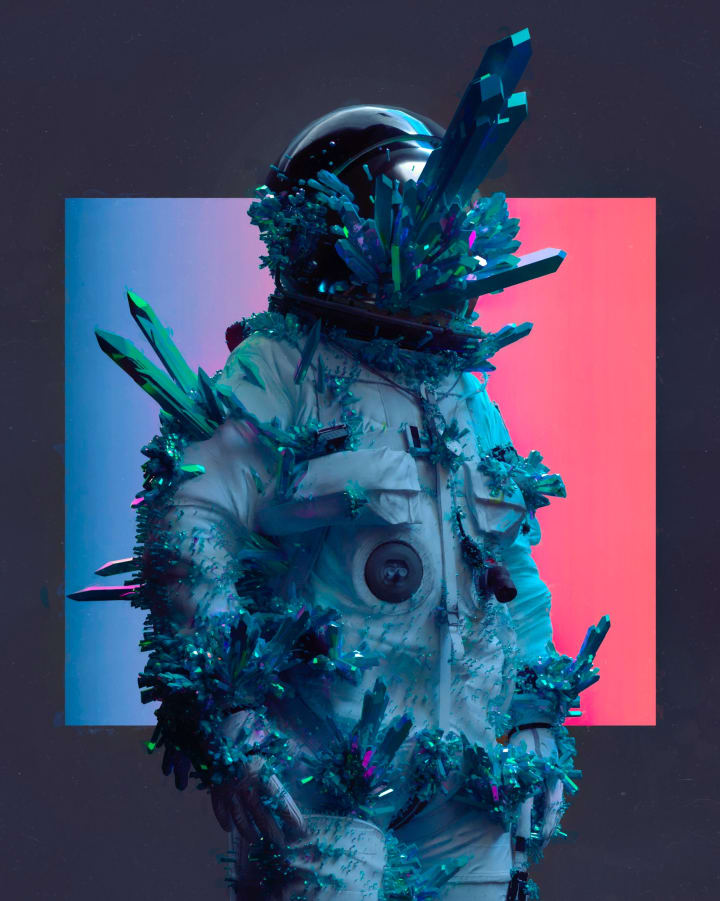Beeple & NFTs: what is going on in the art market?
The latest developments in the world of art and what they mean for us

In the week of the one-year anniversary of the pandemic, history was made again. This time, in the art market with a new ground-breaking auction record. On 11th of March 2021, the first ever auction sale of an NFT (Non-Fungible Token) took place at Christie’s auction house. The work in question Everydays: The First 5000 Days is by an artist Mike Winkelmann, better known as Beeple in the digital art world. The work is a collage of 5000 individual artworks which Beeple has been releasing daily since 2007 (he hadn’t missed a day since he set out to achieve the goal of 5000 works). The auction was open for two weeks on Christie’s website and the bids started at $100; however, they escalated to $15 million by the morning of the closing day, skyrocketing to $40 million in the last 15 minutes of the auction. After almost crashing Christie’s website, the work hammered at $60.25 million (adding the fees to that made the final price $69.3 million). This has made Beeple the third most expensive living artist sold at auction, following Jeff Koons ($91m) and David Hockney ($90m). So, why is this particular sale important for art history and what does it mean for the art market?

For starters, what are NFTs and why it is unusual for an auction house like Christie’s to sell them? NFT is a non-fungible token and it is essentially a piece of ‘crypto art’; any piece of digital art can be made into an NFT, even photos of physical artworks (and such have already been sold for astounding prices too). To create an NFT you need to ‘mint’ it in the blockchain, which means you register it on the blockchain system and it receives a unique code number, making it an ‘original’. Although this new way of making art has come in handy for many digital artists, unfortunately, there are some issues with the system, particularly the sustainability of these crypto-platforms, which can have an irreversible impact on the climate (more on that later). Of course, pictures and screenshots of digital content stay on the internet forever and users still see the artwork regardless of who might own the NFT which has the ‘original’ code on it. NFT auctions have been taking place for a while now but on specialised cryptocurrency platforms like Nifty Gateway and Foundation, Christie's is the first traditional auction house to take up a sale of fully digital artwork. Interestingly, this is not the first time Christie’s is pioneering the art market with bold sales decisions; a couple of months prior, they have auctioned a digital portrait of a Bitcoin - a physical piece of work that is based on the blockchain technology which is also an NFT called Block 21. It was the closest an auction house has come to selling an actual digital piece of art (since the artwork itself was physical), 5 months later they have made history again.

One might ask why this technology is booming now if the crypto-community has been around for a while? The first NFT projects have been released as early as 2015 and have been around since, mostly speculating in the close circles of digital- and crypto- art communities. However, with the rise of Bitcoin (and its popularity) crypto space has been gaining more and more attention from individuals who can afford investments in these new and somewhat unexplored assets. Furthermore, famous individuals like Elon Musk have expressed their interest and belief in the future of cryptocurrency, further incentivising the use and investment into these resources. This layers onto the fact that everyone has been deprived of the physical enjoyment of the art market for a year now. This naturally leads to excitement about any developments in the art-world which are noticeable from the comfort of your own home (and just your laptop). Art collectors (and other individuals who are interested in purchasing art) have become too bored of the online viewing-rooms and virtual-reality 3D models of art fairs. They want to buy again and feel the excitement of ‘owning’ an artwork, hence, the interest in the art pieces which are essentially stored on your laptop (more precisely in your cryptocurrency wallet). And now that NFTs have been endorsed by Christie’s, a major auction house with a brand and reputation attached to it, collectors might not hesitate about whether or not NFTs are considered art. Of course, everyone has their own definition of art and what they consider authentic, but knowing that a major auction house recognises NFTs as legitimate artworks, might reassure many individuals who are less familiar with the digital art-space and cryptocurrency.
However, there is another side to this coin. Whilst history is being made by those who can afford to spend $69 million on digital artwork, the negative environmental impact of every cryptocurrency transaction, and therefore every NFT, exponentially increases. There are some cryptocurrencies and platforms which operate on sustainable energy resources, however, the majority of those platforms, including the most popular – Ethereum and Bitcoin – do not. Currently, all crypto-art is bought and sold in Ethereum, a 6-year-old cryptocurrency which (at the time of writing 14/03/21) is trading at 1 ETH = $1,864.10 (£1,339.08). The process of ‘minting’ an NFT and ‘mining’ (essentially creating) cryptocurrency ‘coins’ requires a lot of energy as the amount of computing power needed to sustain the market, users, mining, minting and all transactions daily can exceed years of average UK person’s electricity consumption. This article explains in extensive detail a number of important sustainability issues with cryptocurrency: the insufficient energy processes in the technicalities of mining that create the unnecessary waste and emissions, how NFTs are contributing to the problem with the crypto-sustainability and how it is different from the impacts of energy use within the physical art market. To highlight these issues in even more detail and put them in perspective, websites such as cryptoart.WTF and carbon.fyi have been created to showcase the usage and emissions of individual NFTs and Ethereum wallets or contracts respectively. For example: if you paste the wallet address for Beeple’s artwork (which is publicly available on Christie’s website) into the calculator, you will find that this wallet user has generated 310,091 tonnes of CO2 emissions in transactions (outgoing and incoming), which is equivalent to 35.8 homes’ of electricity use per year! (and this is just the energy used to power computers to sustain one crypto-wallet!) This is not to say that the sale of Beeple’s artwork alone has generated that much, but the sole use of cryptocurrency for the transaction and acquisition of an NFT contributes to that figure. Not everyone who gets into the crypto-world and NFTs realises the damage that they can make by deciding to participate in activities powered by unsustainable energy resources. Although the artists do pay “gas fees” which range from $40 – $1000 to ‘exhibit’ their work on a chosen sales platform, these do not offset the impact that is created by the wider market and the platforms themselves.
Not to mention that the NFT art-market manifests the existing issues with the physical art market. In a nutshell, not all artists will be selling their works for $60m. Many artists would struggle to make a living from their NFT sales alone even if they have been in the industry for a couple of years. Yet, established artists from the physical art-market who already have a following and recognition are now jumping on the NFT craze – for example, selling pictures of their physical works for prices that digital artists can only dream of. Such oversaturation and the lack of due diligence from those artists creates a negative impact on the digital market (and the environment), helping famous artists get more famous and beating down the emerging ones in oversaturation and lack of attention and interest to the actual digital art-world.

Of course, everyone is free to make their own judgements on whether or not to get on the NFT and crypto-craze now (or wait and see what happens a couple of month/years down the line). Once cryptocurrency goes through the ultimate move to sustainable energy resources, one might revisit the topic with more hope and optimism. In the current climate though, one should do their due diligence before getting involved with the cryptocurrency, make informed decisions on who they support and which platforms they use to do so. And finally, do not think something is good just because it is popular. Yes, art history has been made on 11th of March, but it is another major call to re-evaluate our art-market systems (physical and digital) along with the choices we make in regards to sustainability and our damaging effects on climate change.
Thank you for reading this story! If you enjoyed it, please share and tip if you can. Stay tuned for more art writing! If you want to discuss anything mentioned above, do reach out on Twitter - I'll be happy to talk more art!
Enjoyed the story? Support the Creator.
Subscribe for free to receive all their stories in your feed. You could also pledge your support or give them a one-off tip, letting them know you appreciate their work.






Comments (1)
I have been interested in cryptocurrency for a long time. So thank you for sharing useful links. In order to partially invest in NFT I want to understand it in detail. And I am collecting useful platforms for that. Here is one of them https://icoholder.com/en/nft here I can track market offers and analyze them. And the most important thing is that there is always fresh information, and this is important for an investor.